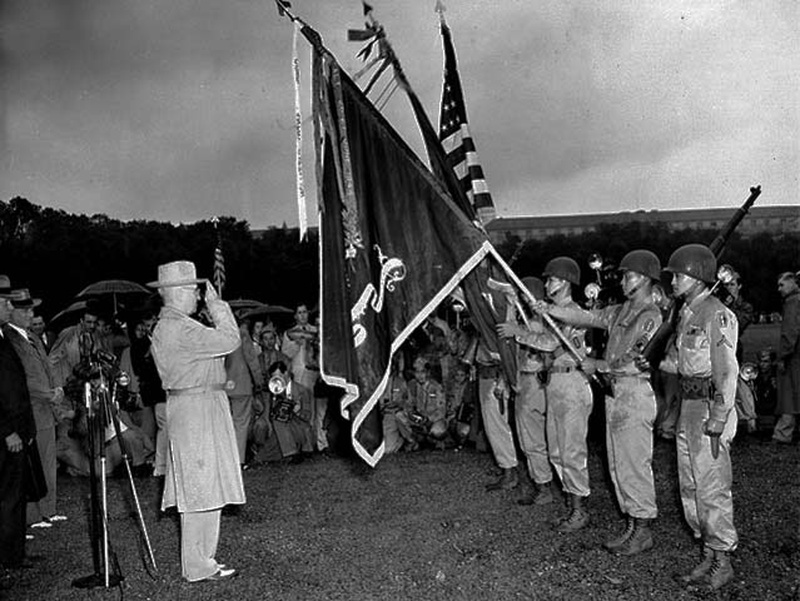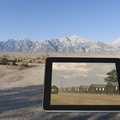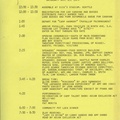Another Battle
On July 15, 1946, in front of the 442nd Regimental Combat Unit, including the 100th Infantry Battalion, 1 , which had achieved many great feats, President Truman said on the White House lawn, "You not only fought the enemy, you fought racism. And you won." The 442nd Regimental Combat Unit is the most decorated unit in the history of the U.S. Army, given its length of service and size.
However, it has taken a long time for the general public to give due recognition to the soldiers of the 442nd Regimental Combat Unit, who returned home after such a remarkable service. When Daniel Inouye, who had just returned to the mainland, entered a hair salon in San Francisco to get a haircut before returning to Hawaii, he was told, "You must be Japanese. We don't cut Japanese hair," even though he was wearing his military uniform. In 1959, when a newspaper photo showed Representative Daniel Inouye, who had been elected to the House of Representatives from Hawaii, raising his left hand toward the Stars and Stripes to take the oath of allegiance, readers wrote letters of protest asking, "Why doesn't that Representative raise his right hand to take the oath?" The editor explained, "Representative Inouye lost his right hand while fighting in Italy."
When Shiro and his friends returned to Seattle, they tried to join the American Veterans Association and the Army Association, but were always turned down. So they set up a kendo club. The building, which had been a dojo before the eviction, was given to the soldiers for the incredibly low price of $1,000 (approximately 100,000 yen). This created a place where the soldiers who had been to war could talk about feelings that only those who had experienced the same thing could understand. It is said that the existence of such a place helped to ease the extreme psychological trauma of the soldiers. The building, which is within walking distance of the Japanese language school, is still used as the NVC (second generation veterans) memorial hall, for community gatherings and lectures. Shiro's many medals are kept here, and Louise Tsuboi Casino, who married Shiro after the war, is still active in the women's group at over 80 years old. 2
On the other hand, there were people who suffered discrimination within the Japanese community. Young people who refused to be drafted and their families were ostracized by the Japanese community and felt ashamed. The mother of Jim Akuts, who also refused to be drafted, returned to Seattle, but was accosted wherever he went, and people who had been close to him gradually left him. He had worked cleaning at a Buddhist church, but was told he no longer needed to come. He was also shut out by the Buddhist church, and feeling that he had no place to belong, he committed suicide.
Although the war overseas was over, there were many problems remaining at home, including racial discrimination, anti-Japanese land laws,3 denial of the first generation’s right to naturalization,4 compensation for forced evictions5 issues regarding the reinstatement of Japanese citizenship to those who had renounced it6 and the misconceptions about draft resisters7.
Lara Supplies
The Japanese-Americans who found solace in the internment camps with miso and soy sauce sent from Japan, when they heard of the plight of Japan after the war, decided to step up. Asano Nananosuke ( Chapter 4 of this series ), who worked hard to establish a Japanese language library at Topaz internment camp, published an article in the Rocky Shimpo on November 19, 1945, entitled "Serious Food Crisis in the Homeland," calling for widespread cooperation, and was approved as an official organization authorized to send relief supplies overseas, LARA (Licensed Agencies for Relief of Asia), and began their activities. 8The situation in Japan at that time is described in an excerpt from "Memories of Japan and LARA Supplies Immediately After the Defeat" by Nishimura Teruzumi, head priest of Byodo-in Temple in Saga:
Orphans who had been burned out by the war, lost their parents and siblings, or were separated from their families and ended up wandering the entertainment districts of the city, as well as orphans who had returned from overseas without parents or relatives, became a major problem after the war, and the number of facilities to house orphans rapidly increased in each prefecture. ...Our nursery housed 35 orphans, so the rations alone were not enough, and we made up for the shortage by growing pumpkins, potatoes, and vegetables in the vacant lot in the cemetery behind the nursery, while we obtained supplies by bartering our mother's clothes with a rural temple for rice, potatoes, etc., but these quickly disappeared from the mouths of the 35 children.
In those days, several paper drums containing canned meat and fish, clothes, etc., were brought in from the US as LARA supplies, and the drums contained powdered milk (or was it skim milk?), which was simply amazing. It was rare and a precious food that I had never eaten before, so I gratefully accepted it, thinking, "Will my mouth swell?"
What was even more surprising was that they said, "The goats have come to Yokohama, so please come and collect them." The prefectural official and my brother went to Tokyo. Over the course of a few days, they transported several goats to Saga in a freight car. I think they were Saanen goats, larger than Japanese goats.
In a time when supplies were at their lowest, these LARA supplies were a welcome gift, and I still remember them vividly as something rare and precious that was designed with children's nutrition in mind. Also, since there were many children who went without food at school at the time, these LARA supplies were distributed to schools (I believe aid was given to children), and I believe this marked the beginning of school lunches after the war. 9
Estelle Ishigo's Heart Mountain
There was a young white woman who spent time at the Heart Mountain Internment Camp. She was a painter and the wife of Arthur Ishigo, a Japanese-American. When they were evicted, she could have stayed in California if she had divorced or separated from him, but she volunteered to go to the camp with Arthur.
Estelle was born into a privileged family, with her father a painter and piano tuner and her mother an opera singer, but both parents were busy with work and she was raised by a nanny. As she got a little older, she was sent from one relative's or friend's house to another, where she was sometimes abused, so it wasn't a happy childhood. After graduating from high school, she ran away from home and enrolled in art school with the goal of becoming a painter, where she met Arthur, an aspiring actor, fell in love and got married. Interracial marriage was prohibited in California at the time, so they traveled to Mexico to get married, but their parents disowned them at the time.
During her lifetime, Estelle said that she had never felt at peace in the Heart Mountain camp, where she lived among Japanese Americans who shared the same pain and dreams as her. It was an important place for her, where she finally felt accepted by everyone. 10Estelle 's wish was, "When I die, I want my ashes to be scattered from the top of Heart Mountain."
Who do you think made Estelle's wish come true? It was Bacon Sakatani, who told us about his childhood on Heart Mountain.
The story of bacon
I wanted to hear the story, so I contacted Bacon Sakatani. He sent me a copy of the eulogy given at Estelle's memorial service, as well as the English and Japanese versions of Estelle's book, "Lone Heart Mountain." I also spoke to him on the phone, and he seemed to be in good health. Now, back to the story of Estelle.
In 1984, Bacon received a request to find Estelle, as they wanted to exhibit her painting at the Heart Mountain Internment Memorial Park. After a long search, he finally found her. After returning home that day, he wrote the following:
They found her living in a rundown basement apartment with several broken windows, letting in the wind and rain. Both of her legs had been amputated below the knee due to gangrene, and she sat in a wheelchair. The sheets on her bed were dirty as if they had never been washed, and the slip she was wearing was dark and stained. Her landlord fed her warm soup once a day. She had recently had surgery on her abdomen, so she needed to eat small meals several times a day.
They survived on Campbell's soup cans and a six-inch electric stove that they left on to keep the room warm. They had no money, so they gave their Social Security benefits to their landlord in exchange for room and board .
Thus began Bacon's friendship with Estelle, who visited the mountain frequently thereafter. Upon hearing Estelle's wish to republish Lone Heart Mountain, which had been out of print, so that people all over the world could know what happened to the Japanese community during the war, Bacon reached out to Heart Mountain alumni to raise funds and successfully resold the book. On the day her wish was granted, Estelle was said to have been very happy as she signed copies of the book for her friends and fans. To fulfill Estelle's final wish, who passed away in February 1990, Bacon set off for Heart Mountain the following year. 12
Notes:
1. Nisei soldiers drafted from Hawaii excelled during training and went to Europe as part of the 100th Infantry Battalion, where they joined the 442nd Regimental Combat Unit, which was made up of soldiers who had volunteered from camps in Hawaii and on the mainland.
2. Louise Tsuboi Kashino, interviewed by Yuri Brockett, Jenny Hones and Hitomi Takagi, August 22, 2013 at Bellevue, Washington
3. In 1956, California repealed its Alien Land Law, allowing the Issei to own land.
4. In 1952, the Japanese Naturalization Act was passed. Finally, the first generation of Japanese born immigrants were able to obtain American citizenship.
5. In 1948, the Forced Evacuation Claims Act came into effect. The compensation was only for "damage or loss to real or personal property," and the 1942 assessed value was used. Receipts were required, and 10% was deducted as government legal fees. It was not a satisfactory solution. Estelle and Arthur Ishigo made a list of all the property they had lost in the eviction, estimating that it was worth at least $1,000. However, in 1952, the government contacted them to settle for $100. It was far from satisfactory, and they spent the next four years negotiating with politicians and government officials and writing letters, but when they finally gave in and received a check for $102.50 (about 10,500 yen), Arthur's eyes were filled with tears, according to Estelle.
6. More than 5,000 Nisei and Kibei citizens who were in Tule Lake renounced their citizenship. They did not renounce their citizenship voluntarily, but because of pressure from radical pro-Japanese groups and the administration, and because of a momentary lapse in judgment, while in the camps where they could not see any future prospects and were rife with rumours. They soon realised their mistake, but it was too late. San Francisco lawyer Wayne Collins worked to restore the citizenship of the 3,700 or so young people who remained in the US. He also helped Peruvians who had been brought to the US as prisoner exchange personnel to remain in the US after the war. In her book, American Internment Camps: The Japanese Who Endured Humiliation (translated by Seiji Yamaoka), Michiko Weglin writes, "Before this whole sad episode came to an end in 1968, Collins wrote some 10,000 depositions in defence and re-defence of countless clients in the US and Japan..." and dedicates the book to Wayne Collins.
7. On December 24, 1947, President Truman granted amnesty to draft resisters. However, it was not until July 2000 that the JACL (Japanese American Citizens League), which had continued to marginalize and hide them, resolved to apologize to draft resisters.
8. Yoshimichi Nagae, "The Dawn of Japanese Americans: Testimony of a First Generation Journalist in the United States," Iwate Nippo, 1987
9. www.a50.gr.jp/jp/lara.htmlAt that time, many families continued to send packages to Japan on their own, and both Ayako and Mako remember that their parents, although poor, were preparing packages to take to Japan.
10. Okazaki, Steven. (Director/Producer) (1990). Days of Waiting: The life and Art of Estelle Ishigo [Documentary Film]. Asian American Media.
11. Estelle Ishigo, translated by Nobuaki Furukawa, "Lone Heart Mountain: Days in a Japanese American Internment Camp," Sekifusha, 1992
12. Sakatani, Harumi Bacon, personal communication, March 10, 2014.
*Reprinted from the 137th issue (April 2014) of “Children and Books,” a quarterly magazine published by the Children’s Library Association.
© 2014 Yuri Brockett







